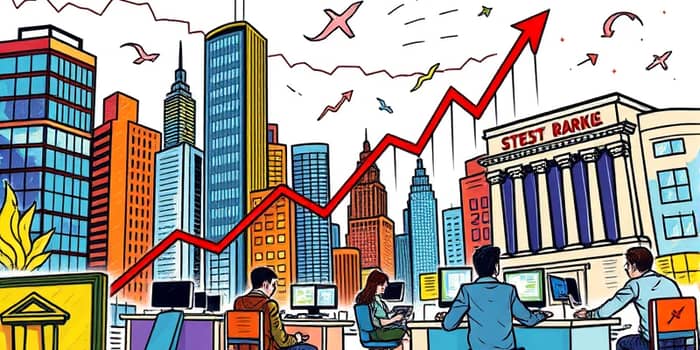Interest rates are the pulse of the financial world, dictating the flow of capital and shaping the valuation of every traded share. For investors, understanding the interplay between central bank policy and equity markets is crucial to navigating cycles of growth and contraction.
As economies breathe and adapt, stock prices often act like a mirror to borrowing costs. By exploring how rate changes ripple through corporate profits, sector performance, and investor sentiment, we can craft strategies that thrive in any environment.
Understanding the Inverse Relationship
One of the most reliable patterns in finance is the inverse correlation between rates and equities. When central banks raise rates, the cost of borrowing climbs. Companies pay more interest on debt, curtail expansion plans, and see reduced net income. These pressures weigh on stock valuations.
Simultaneously, higher rates increase the discount rate used in valuation models, lowering the present value of future corporate earnings. Investors also shift funds toward bonds and other fixed-income instruments that now offer more attractive yields, reducing demand for stocks.
- Increased borrowing costs squeeze profit margins and limit growth.
- Discounted cash flows shrink the present value of expected earnings.
- Investor demand shifts toward higher-yielding instruments.
Immediate and Lagged Market Reactions
Equity markets are forward-looking, swiftly adjusting prices as soon as rate decisions become likely. Traders incorporate expectations into valuations within hours or days. However, the broader economic impact unfolds more gradually.
Consumer spending patterns, corporate capital expenditures, and hiring plans may take quarters to reflect higher financing costs. In turn, earnings reports and balance sheets reveal the full effect over six to twelve months, creating a lag between policy action and bottom-line impact.
Sectoral Impacts and Stock Types
Not all stocks respond the same way when rates shift. The financial sector, for instance, may benefit from rising rates because banks earn higher net interest margins on loans versus deposits.
Conversely, growth-oriented technology companies—valued heavily on future earnings—tend to underperform during tightening cycles due to sensitivity to discount rate changes. Defensive or dividend-paying stocks often hold up better as investors seek reliable cash flows.
- Financials: higher net interest margins can boost profitability.
- Growth Stocks: Valuations contract when rates climb.
- Defensive Stocks: Stable dividends offer relative shelter.
Historical Context: Fed Policy from 2020 to 2025
The Federal Reserve’s actions during recent years illustrate the power of rate policy. In early 2020, rates were slashed to near zero to cushion the economic shock of the pandemic. This extraordinary accommodation propelled equity markets to new highs.
By 2022, inflation pressures prompted aggressive rate hikes to multi-decade highs, testing corporate balance sheets and investor resolve. In September 2024, the Fed pivoted, cutting rates by 50 basis points—the first reduction in over four years—to support growth and employment.
Meanwhile, the 10-year Treasury yield climbed from roughly 3.6% in mid-September 2024 to 4.4% by May 2025, driven by easing trade tensions and a brighter growth outlook. Analysts noted that models as of March 31, 2025, still indicated the US market remained overvalued given normalized rate levels.
Investor Strategies in a Changing Rate Environment
Savvy investors adjust portfolios to mitigate risk and seize opportunities as rates fluctuate. During tightening phases, rotating into shorter-duration bonds reduces sensitivity to yield changes.
Shifting weight toward financials can capture higher margin prospects, while adding defensive staples or dividend aristocrats cushions portfolios against volatility. When rates decline, growth sectors and long-duration assets often rebound sharply.
- Shorten bond maturities to limit duration risk.
- Rotate into financials for rising yield environments.
- Increase defensive exposures for stability in uncertainty.
Broader Economic Impact and Market Valuations
Interest rate shifts reverberate beyond corporate boardrooms. Higher borrowing costs can dampen consumer spending on big-ticket items like homes and autos. Reduced demand may slow GDP growth, feeding back into corporate revenues and profits.
When rates are low, investors often chase risk assets, inflating price-to-earnings ratios and creating liquidity-driven bubbles. As rates normalize, those valuations contract, restoring equilibrium between risk and return.
Long-term economic impact depends on the pace and magnitude of rate moves—steady, transparent policy adjustments tend to be less disruptive than abrupt, unexpected hikes or cuts.
Concluding Insights
Interest rates are a central pillar in the architecture of stock market performance. By recognizing the fundamental relationship between rates and valuations, investors can anticipate potential market pivots and adjust strategies accordingly.
Maintaining a diversified portfolio, staying attuned to Fed policy signals, and rotating assets to match the rate cycle are prudent ways to navigate uncertainty. Whether rates rise to combat inflation or fall to spur growth, the informed investor can position for resilience and opportunity.
In the dynamic travel between credit costs and equity prices, knowledge, patience, and adaptability remain the greatest assets.
References
- https://www.investopedia.com/investing/how-interest-rates-affect-stock-market/
- https://www.usbank.com/investing/financial-perspectives/market-news/how-do-rising-interest-rates-affect-the-stock-market.html
- https://www.investopedia.com/articles/stocks/09/how-interest-rates-affect-markets.asp
- https://www.goldmansachs.com/insights/articles/how-higher-rates-affect-us-stocks
- https://www.ig.com/en/trading-strategies/what-are-the-effects-of-interest-rates-on-the-stock-market-220705
- https://www.currentmarketvaluation.com/models/10y-interest-rates.php
- https://www.investopedia.com/terms/s/stockmarket.asp
- https://www.koho.ca/learn/how-do-interest-rates-impact-the-stock-market/










